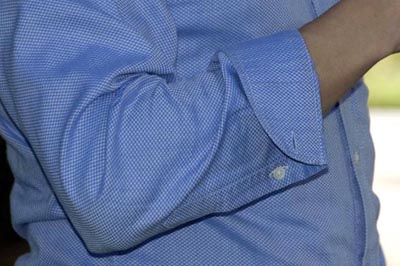In 2011, MARADMIN 621/11 came down from headquarters Marine Corps.
In a nutshell — it was determined that the Marines would no longer roll up their shirt sleeves of their combat utility uniform while in garrison.
A small detail really.
Yet that small detail led to many heated debates, including this interesting one over at the Marine Corps Times.
My point?[amazon asin=B003LO20WS&template=*lrc ad (right)]
Men — and this goes for Marines and civilians alike – often care about the rolling of their sleeves, and if you’re going to do it, you might as well learn how to do it properly.
Now let me be clear — I don’t believe there is only one “right way” to roll your sleeves.
But I do think that some ways look better than others.
The goal of this article is to help you understand when sleeve rolling is appropriate and to give you three how-to options when doing so.
Rolled Sleeves: When and Why to Wear Them
1. Practical Necessity — washing the hands, doing heavy lifting where the wrists and forearms are strained, working on something dusty, and so on are all perfectly normal reasons to pull back the shirt sleeves. Anytime your sleeves might get in the way or dirty or caught in a moving part — roll ‘em up. Thus it is the universal “men at work” style. Examples of this includeunclogging a toilet, or [amazon asin=B005ESMGZU&template=*lrc ad (left)]perhaps rescuing a cat from a tree (though in the latter case you might actually leave the sleeves up to avoid scratches on your skin). On a side note — did you know that men used to roll up their jacket sleeves as well? To accommodate this, jackets had working buttons along the end of the sleeve that made the practice simple. Over the last 100 years, as mass manufacturing took over, the buttons became non-functional, but for decorative reasons clothing designers kept them in place.
You might also roll up the sleeves of a shirt that fits well, except for sleeves that are too long. But this is only a temporary solution! Be sure to get your shirt tailored for the best fit (and the ability to roll down your sleeves with confidence when the situation calls for it!).
2. Heat — When it’s very hot and stagnant, rolling up the sleeves lets air flow directly over more of your skin. Every little bit helps. While the appropriateness of rolled sleeves varies by workplace (see below), anytime you’ve got direct sunlight on your skin, rolled sleeves are acceptable. They’re also nice when you work or live inside a place where the temperature fluctuates a great deal, as it’s nice[amazon asin=B0057YLDF0&template=*lrc ad (right)] to be able to roll them down when the A/C’s blowing on you, and roll them up when the room gets stuffy.
3. Casual Attitude — As a purely stylistic expression, rolled sleeves mostly serve to “dress down” something that would otherwise be too formal/dressy for the occasion; rolling back the shirt sleeves sends a visual signal that says “relaxed.” For example, upon leaving the office for a less-formal work function or social gathering, men with their jackets off and their sleeves rolled up is classic “Happy Hour” style. A collared shirt with rolled up sleeves is also a popular look for men out at clubs and bars over the weekend. And when in charge of a meeting or hosting a party, it’s a great way to signal to others that it’s okay to not worry about formalities.
This is why the question of whether rolled up sleeves at the office is appropriate comes down to the culture of a particular workplace: in a casual, informal office, rolled sleeves are often the norm, while in a very conservative corporate environment, sleeves may never leave a man’s wrists. Check out your fellow employees to see what the prevailing norm is, and even if you do work in an office where [amazon asin=0312361653&template=*lrc ad (left)]rolled sleeves prevail, I’d recommend rolling them down when meeting with an important client, or when a head honcho is visiting the office, to give yourself a more professional appearance.
To sum up: When you’re wearing a long-sleeved dress or work shirt, it’s best to wait for one of the three circumstances listed above before rolling the sleeves up. If it’s not achieving one of those practical effects, you risk looking sloppy or thoughtless.
How to Roll Your Sleeves: Basic Guidelines
There are a number of different styles for rolled sleeves; we’ll talk about three of the specific folds in a minute.
First, here are some important guidelines for any style of rolled sleeve:
- Several inches of wrist visible, at minimum. You don’t want it to look like the shirt is too big for you and you had to roll the sleeves just to keep your hands from being swallowed.
- Forearms yes, elbows only if you’re going to be working. For casual situations, keep the big, pointy, outer bone of your elbow[amazon asin=B003WZ3LM4&template=*lrc ad (right)] inside the shirt.
- Suit or sport jackets usually aren’t rolled (and when they are, they are more pushed up than rolled) unless there’s an immediate and practical need. You can do it (if your jacket has working sleeve buttons), but be aware that it’s a fashion-forward look.
Regardless of the shirt or the style these are always good guidelines. If you’re going to break one, have a very clear stylistic goal in mind, and double-check the look in the mirror.
Rolling Method #1: The Casual Forearm Roll
A casual shirt roll that is also — conveniently — the easiest to roll back down without wrinkles, as it involves the least folding:
1. Unbutton the cuff and any “gauntlet” buttons further up the sleeve.2. Flip the cuff back and inside out.

3. Fold over once, hiding the cuff behind a band of sleeve fabric.
 4. Stop there, tucking the corners of the cuff in neatly.
4. Stop there, tucking the corners of the cuff in neatly.
The result should be a single small roll around the middle of your forearm. It doesn’t need to be tight because it’s already as far down the arm as it’s going to slide. This is a particularly good style to use when you have multiple layers involved, such as a dress shirt under a light sweater. It also looks good on men with thin arms.




